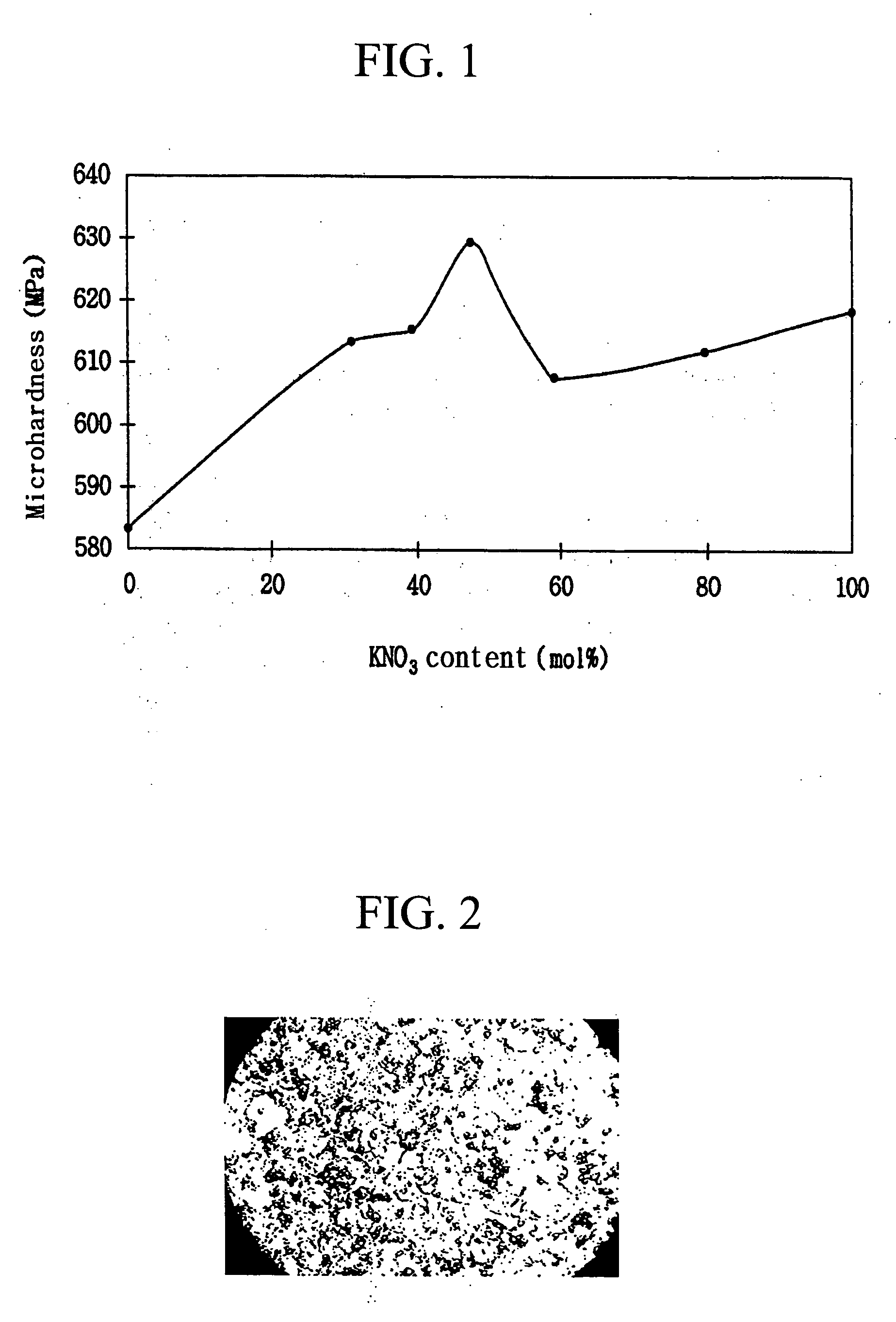Method for strengthening flat glass plate for display
- Summary
- Abstract
- Description
- Claims
- Application Information
AI Technical Summary
Benefits of technology
Problems solved by technology
Method used
Image
Examples
example 1
[0022] A powdered mixture of potassium nitrate (KNO3) and aluminum oxide (Al2O3) having the composition shown in Table 1 was placed on the surface of a silicate glass plate containing 4.8 w / w % of Na2O, 6.2 w / w % of K2O, 1.66 w / w % of MgO, 5.25 w / w % of CaO, 7.2 w / w % of SrO, 8.0 w / w % of BaO, 2.7 w / w % of ZrO2, 6.7 w / w % of Al2O3 and 57.3 w / w % of SiO2 as main components, to form an 1 to 2 mm-thick solid layer thereon.
[0023] The glass plate with the solid layer was placed in a furnace, heated to 480° C. over 1 hr, and then, maintained at that temperature for 1 hr. The heat-treated glass plate was cooled to 20° C. over 2 hrs and washed with distilled water to remove the residual powder layer.
[0024] The average microhardness (MPa) of each of the glass plates ((1-1) to (1-6)) thus obtained was determined at five points using a 100 g load with a 15 Vicker's hardness gage and compared with that of the original untreated glass plate (control). The results are shown in Table 1. The chan...
example 2
[0026] A powdered mixture of potassium nitrate (KNO3), aluminum oxide (Al2O3) and aluminum trichloride (AlCl3) having the composition shown in Table 2 was placed on the surface of the same glass plate as in Example 1, to form an 1 to 2 mm-thick solid layer thereon.
[0027] The glass plate with the solid layer was placed in a furnace, heated to 460° C. over 1 hr, and then, maintained at that temperature for 1 hr. The heat-treated glass plate was cooled to 20° C. over 2 hrs and washed with distilled water to remove the residual powder layer.
[0028] The average microhardness (MPa) of each of the glass plates ((2-1) to (2-4)) thus obtained was determined at five points using a 100 g load with a Vicker's hardness gage. The results are shown in Table 2. An SEM photograph of the surface of the glass plate (2-4) treated with a mixture of 50 mol % of potassium nitrate, 40 mol % of aluminum oxide and 10 mol % of aluminum trichloride is shown in FIG. 2.
TABLE 2Salt-containingAveragemixture (mo...
example 3
[0030] The procedure of Example 1 was repeated except that a mixture of 35 mol % of potassium nitrate and 65 mol % of aluminum oxide was used, and that the heat-treatment (ion-exchange) temperature was changed as shown in Table 3, to prepare various glass plates.
[0031] The average microhardness (MPa) of each of the glass plates ((3-1) to (3-5)) thus obtained was determined at five points using a 100 g load with a Vicker's hardness gage. The results are shown in Table 3.
TABLE 3Ion-exchangeAverageStandardSampletemperature (° C.)microhardness (MPa)variationControl—583.513.8(3-1)360595.110.6(3-2)380599.48.7(3-3)400610.26.6(3-4)450618.45.3(3-5)500620.66.2
[0032] As shown in Table 3, the glass plates ((3-1) and (3-2)) heat-treated at temperatures lower than 400° C. exhibited unsatisfactory strengths, while the glass plates ((3-3) to (3-5)) heat-treated at 400˜500° C. in accordance with the inventive method show uniform and satisfactory strengths.
[0033] As described above, in accordance...
PUM
| Property | Measurement | Unit |
|---|---|---|
| Temperature | aaaaa | aaaaa |
| Temperature | aaaaa | aaaaa |
| Temperature | aaaaa | aaaaa |
Abstract
Description
Claims
Application Information
 Login to View More
Login to View More - R&D
- Intellectual Property
- Life Sciences
- Materials
- Tech Scout
- Unparalleled Data Quality
- Higher Quality Content
- 60% Fewer Hallucinations
Browse by: Latest US Patents, China's latest patents, Technical Efficacy Thesaurus, Application Domain, Technology Topic, Popular Technical Reports.
© 2025 PatSnap. All rights reserved.Legal|Privacy policy|Modern Slavery Act Transparency Statement|Sitemap|About US| Contact US: help@patsnap.com


